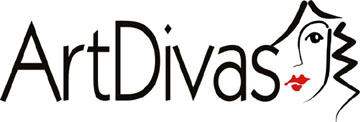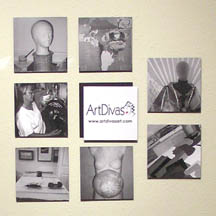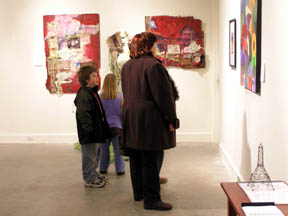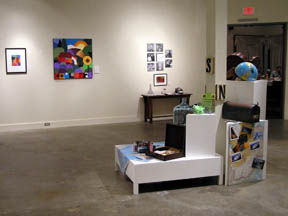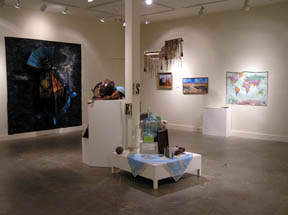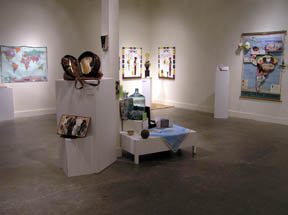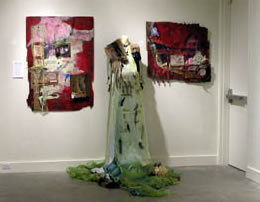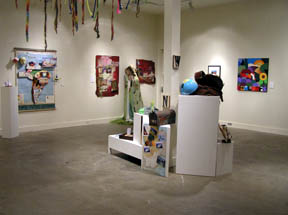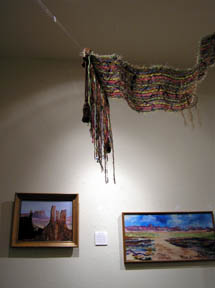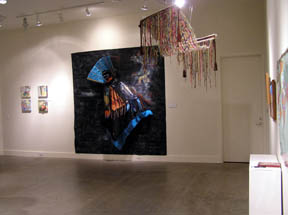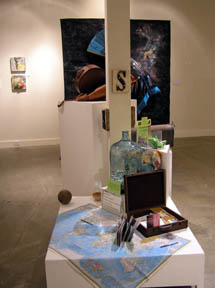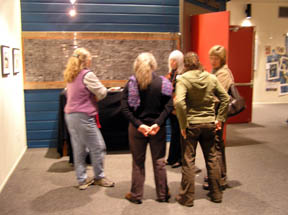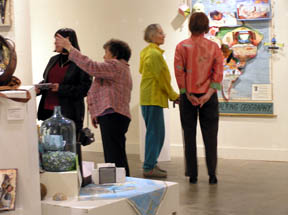Diva (noun) plural: divas. 1. Goddess 2. Prima Donna: principal female singer in an opera or concert organization. - Merriam Webster's Collegiate Dictionary
By definition, a diva is a formidable personality.
Since divas aren't known for working particularly well with others - let alone others of their own kind - one hardly would expect to find seven of them collaborating on a regular basis.
But they do.
In our neighboring county of Solano, several separate artists were working in their diverse media, when it occurred to them that getting together with each other on a regular schedule - exchanging ideas, sharing information and critiquing each other's work - might benefit all.
Isolation is a hurdle that artists must overcome. Granted, artists need to be self-starters in our society, but they can find themselves wondering what steps to take next, to get their work out of the studio and into the public eye.
The Solano group began as a sort of sisterhood of three founding members, sharing their thoughts via e-mail and taking art-focused day trips. The three eventually became eight, then seven. Seven seemed to work just right.
Next, they chose to make group artworks. Each member was specialized in different areas: painting, textiles, digital images and so forth. What could they make that would allow all members to participate equally?
One project was a 30-foot abstract mural, from which could be cut small sections for framing and sale. (As a contribution to a fundraiser, this worked particularly well.)
Finally, they settled on the modern media of assemblage, collage and mixed media. Assemblage is the mixture of scraps, particular three- dimensional objects, into a single artwork. Collage is the use of various materials - paper, cloth or wood - glued onto a surface. Mixed media is a term, coined in the 1960s, for an nontraditional artwork made by combining separate media into one, like using pencil, paint and collage to make an image.
By now, our Solano artists needed a group name: handier than listing each individual, and catchy, to court the public. So, three years ago, they chose to become the ArtDivas.
The Davis Art Center's first 2008 exhibit is a showing of the ArtDivas' third group project, 'Maps & Messages: An Artful Journey,' along with individual works by each member of the collective. The joint effort is housed inside the walls of the Tsao Gallery, while the individual pieces line the walls of the west corridor and the atrium.
'Messages & Meanings' was inspired by a windfall of colorful but obsolete maps and globes, received by Jan Radesky from a retiring social studies teacher. Most members of the collective used the material in a suite of works exploring the theme.
Some of the pieces are interactive, meaning that gallery visitors can use materials provided to add to the artwork in some way.
Radesky employed a hanging map of South America for 'Inner Hemispheres.' She chose to illustrate a poem by Chilean poet and diplomat Pablo Neruda, by creating overlying paper panels of scenes and excerpts.
Visitors can read the poem 'Muchos Somos' ('We Are Many') - either in Spanish or English - on flyers next to the map. The panels themselves are decorated with engaging watercolor and collage images.
Janet Manalo's 'Flights of Fantasy: Beyond the Universe' has the combination of an arresting concept and large scale. A cosmic background is depicted on a huge, dark cloth draping the wall, while in front of it floats a three-dimensional, life-size figure clothed in appropriately celestial garments. It's a show-stopper.
Ann Jacobs' 'Genesis of a Nation: Following the Silk Road to the Gold Mountain' also has a full-size mannequin at its center, dressed in taffeta silk and furs. It stands between two large painted panels, which trace the migration of Asians to California (called 'Gold Mountain' by Chinese prospectors in 1849).
The most interesting parts of this artwork are the multitude of creation stories - from Asian nations to Native American tribes - fixed to each panel, particularly one from China.
Many art-lovers have a weakness for the archaeology of ancient Egypt; they'll appreciate Anna Maria Sablan's 'Artifacts: Tomb of High Priestess Nafretiri, 18th Dynasty, Egypt.' Wall paintings and inscriptions are duplicated in two canvases, with rough surfaces like crumbling stucco. A replica of the priestess' head dress, in three dimensions, stands on a pedestal between the paintings.
The center of the gallery space features Robin Rossi's tongue-in-cheek 'Rossi Royal Railways,' in which she uses leather suitcases to contain striking images and props to convey her message. Other containers include a mailbox, to which the observer is invited to add a postcard, and a mammoth bottle to which one can add a note about a favorite vacation.
Annie Johnson also has a interactive aspect to her 'Magic Carpet' artwork. The carpet, loosely woven from various yarns, is suspended from the ceiling near two landscape paintings, a world map and a notebook. The viewer is encouraged to add a note about a favorite vacation spot, then mark it on the map.
Brigette Sukeforth has two brightly colored paintings, one large and one small. Highly stylized, rounded landscape features make these paintings quite abstract, but rather handsome.
Other individual works hanging on the atrium walls are worth lingering to see. Particularly recommended are Sablan's collages - 'Asia,' 'Asia Too' and 'Butterfly Girl' - as charming combinations of their elements.
Radesky has a flair for watercolor, as evidenced by 'The Cave Dweller' and 'Italia.' Rossi's 'Sunrise' photo etching is rather novel, and computer expert Janet Manalo used her expertise to create the digital collage 'Origins.'
Don't miss Jacobs' artworks inspired by her two-month tour: 'Pacific Rim Visual Journal 2007." Combinations of maps, watercolor images and colorful postage stamps make for vivid entries like 'The Far East.' Other artworks are collages of photograph images, such as 'Sydney and the Aborigine.'.
Stop by the Davis Art Center and let the ArtDivas work their magic on you. That'll start your New Year right.
